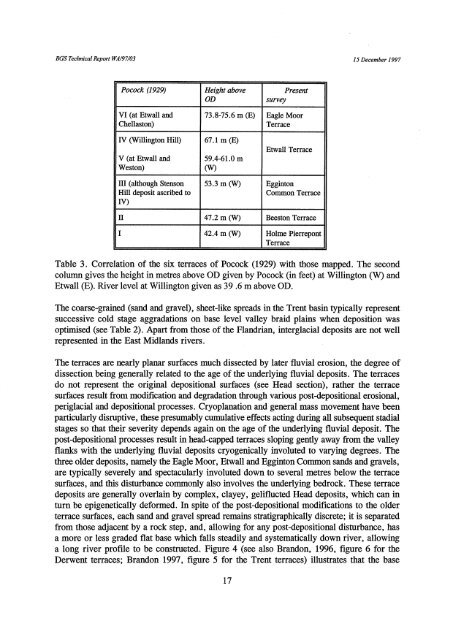Download (3723Kb) - NERC Open Research Archive - Natural ...
Download (3723Kb) - NERC Open Research Archive - Natural ...
Download (3723Kb) - NERC Open Research Archive - Natural ...
Create successful ePaper yourself
Turn your PDF publications into a flip-book with our unique Google optimized e-Paper software.
BGS Technical Report WM97/03 15 December 1997<br />
Pocock (1 929)<br />
VI (at Etwall and<br />
Chellaston)<br />
IV (Willington Hill)<br />
V (at Etwall and<br />
Weston)<br />
I11 (although Stenson<br />
Hill deposit ascribed to<br />
Height above<br />
OD<br />
73.8-75.6 m (E)<br />
67.1 m (E)<br />
59.4-61.0 m<br />
(W)<br />
53.3 m (W)<br />
Present<br />
survey<br />
Eagle Moor<br />
Terrace<br />
Etwall Terrace<br />
Egginton<br />
Common Terrace<br />
I1<br />
I<br />
47.2 m (W)<br />
42.4 m (W)<br />
Beeston Terrace<br />
Holme Pierrepont<br />
Terrace<br />
Table 3. Correlation of the six terraces of Pocock (1929) with those mapped. The second<br />
column gives the height in metres above OD given by Pocock (in feet) at Willington (W) and<br />
Etwall (E). River level at Willington given as 39.6 m above OD.<br />
The coarse-grained (sand and gravel), sheet-like spreads in the Trent basin typically represent<br />
successive cold stage aggradations on base level valley braid plains when deposition was<br />
optimised (see Table 2). Apart from those of the Flandrian, interglacial deposits are not well<br />
represented in the East Midlands rivers.<br />
The terraces are nearly planar surfaces much dissected by later fluvial erosion, the degree of<br />
dissection being generally related to the age of the underlying fluvial deposits. The terraces<br />
do not represent the original depositional surfaces (see Head section), rather the terrace<br />
surfaces result from modification and degradation through various post-depositional erosional,<br />
periglacial and depositional processes. Cryoplanation and general mass movement have been<br />
particularly disruptive, these presumably cumulative effects acting during all subsequent stadia1<br />
stages so that their severity depends again on the age of the underlying fluvial deposit. The<br />
post-depositional processes result in head-capped terraces sloping gently away from the valley<br />
flanks with the underlying fluvial deposits cryogenically involuted to varying degrees. The<br />
three older deposits, namely the Eagle Moor, Etwall and Egginton Common sands and gravels,<br />
are typically severely and spectacularly involuted down to several metres below the terrace<br />
surfaces, and this disturbance commonly also involves the underlying bedrock. These terrace<br />
deposits are generally overlain by complex, clayey, geliflucted Head deposits, which can in<br />
turn be epigenetically deformed. In spite of the post-depositional modifications to the older<br />
terrace surfaces, each sand and gravel spread remains stratigraphically discrete; it is separated<br />
from those adjacent by a rock step, and, allowing for any post-depositional disturbance, has<br />
a more or less graded flat base which falls steadily and systematically down river, allowing<br />
a long river profile to be constrwted. Figure 4 (see also Brandon, 1996, figure 6 for the<br />
Derwent terraces; Brandon 1997, figure 5 for the Trent terraces) illustrates that the base<br />
17
















